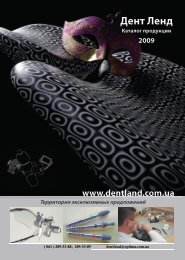CASTING
CASTING
CASTING
Create successful ePaper yourself
Turn your PDF publications into a flip-book with our unique Google optimized e-Paper software.
Come si ottiene<br />
una buona<br />
fusione<br />
Rispettando le temperature di colata<br />
Il controllo della temperatura di colata è il parametro<br />
più importante, per mantenere inalterate le<br />
caratteristiche metallurgiche delle leghe.<br />
Il rispetto dei dati di colata, evita la sublimazione dei metalli a<br />
basso punto di fusione, contenuti nelle leghe stesse.<br />
Un metallo fuso alla giusta temperatura, potrà così garantire tutte<br />
le caratteristiche indicate dalla casa produttrice. Diversamente<br />
vi possono essere modifi cazioni sulla struttura metallurgica<br />
che creano alterazioni tecniche e problemi durante le future<br />
lavorazioni.<br />
Colata con spinta omnidirezionale<br />
Le leghe dentali, sono composte da metalli, con diverso peso<br />
specifi co. Utilizzando metodi con iniezione a centrifuga avremo<br />
una spinta unidirezionale che immette all’interno del cilindro,<br />
prima le componenti ad alto peso specifi co e successivamente le<br />
altre.<br />
Con i sistemi a pressofusione Tecno-Gaz, il metallo entra<br />
staticamente nel cilindro, poi avviene una spinta<br />
omnidirezionale e costante su tutto il cilindro,<br />
permettendo una perfetta stratifi cazione del metallo.<br />
Colata in vuoto<br />
Per avere alta resistenza meccanica e grande precisione, la<br />
colata deve avvenire con atmosfera senza presenza<br />
di aria. Questo permette che non si inglobi aria nel manufatto,<br />
garantendo chiaramente massima compattezza della lega.<br />
How to achieve<br />
a good casting<br />
Follow casting temperature requirements<br />
Keeping control over casting temperature is the most<br />
important requirement to maintain the metallurgic features of<br />
the alloy.<br />
Compliance with the casting data and specifi cations is essential to avoid<br />
sublimation of the low melting point metals contained in the alloy.<br />
A metal molten at the appropriate temperature will have all the features<br />
prescribed by the manufacturing company, otherwise there may be some<br />
changes in the metallurgic structure of the metal that may cause changes<br />
in technical properties and problems during the subsequent processing<br />
phases.<br />
Casting with omnidirectional pressure<br />
Dental alloys are composed of several different metals, each with its own<br />
specifi c density. By using centrifugal injection techniques the result will<br />
be a mono-directional pressure in which the metals with higher specifi c<br />
densities are introduced in the cylinder before the ones with lower<br />
densities.<br />
Using the Tecno-Gaz pressure die-casting techniques, the metal is<br />
introduced statically in the cylinder and then the cylinder is exposed<br />
to an omni-directional and constant pressure that allows<br />
perfect layering of the metal.<br />
Vacuum casting<br />
To achieve high mechanical resistance and accuracy the casting shall<br />
be carried out in an airfree environment. This ensures a completely<br />
non porous alloy casting.<br />
La corretta temperatura di<br />
fusione permette di ottenere<br />
metalli con una struttura<br />
molecolare più stabile.<br />
The correct casting temperature<br />
allow to obtain metals<br />
with a more stable molecular<br />
structure.



